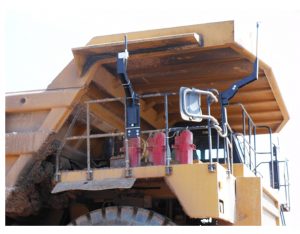Let’s look at the path to automation inside an industry that has a particularly long list of challenges – like the $680B mining industry. Like many industries, mining is facing a severe worker shortage, driven particularly by the dangerous, difficult, and remote work conditions. For mining, we’re typically talking severe weather conditions – like in the middle of Australia with months of extreme heat. And where workers leave home for weeks or months at a time – living in barracks away from their families.
To help solve these problems, the mining industry is turning autonomous vehicles and autonomous operations into a reality. Autonomous operations allow you to give those workers much better working conditions. It enables you to operate in those conditions 24×7 to maximize investments. It puts less wear on equipment that costs millions of dollars each. And new technologies attract new workers and a more diverse pool to offset a workforce that is rapidly approaching retirement.
 Let’s dig inside the mining industry, see where the move to autonomous operations is making life better while delivering real business value, and how this applies to other industries, like distribution centers, oil and gas, and manufacturing.
Let’s dig inside the mining industry, see where the move to autonomous operations is making life better while delivering real business value, and how this applies to other industries, like distribution centers, oil and gas, and manufacturing.
The Path from Analog to Digital to Autonomous
Often the first step into autonomous operations for mining is digital dispatch – where drivers are provided the correct route to travel from the mining site location to the dump. One of our customers installed an IoT wireless mesh infrastructure across their mine sites to deliver apps on their mobile fleet, as the remote location had no cellular or wireless capabilities. They were able to achieve ROI within 6 months simply from trucks not missing their routes. With digital dispatch, the mine company can determine the optimal path, provide that to the driver, and have insight into any departures from that path.
Safety and Speed with Remote Operations
Remote operation takes the digital process one step closer to autonomy. Here one remote operator can drive four dozers off of the same joystick. Not only is it safer for the operator, it also saves considerable time and money. Consider all of the challenges with underground mining. To simply get workers from the barracks to the remote underground location, the transport busses can take an hour or more each way. And in hot mines, the workers need to exit their equipment and go into refuge chambers to cool down. Not only does that cost money, it puts workers in unsafe places. With remote operations powered by industrial IoT access points and switches, now it takes only a few minutes to get remote equipment in that underground mine operating for the shift.
Delivering Accuracy, Efficiency, and Safety with Autonomous Operations
Let’s look at how autonomous operations is transforming open pit mining and haul trucks. To understand the scale of these operations, consider that these haul trucks can carry a payload of nearly 400 tons and are as long as 3 full-size pick-up trucks. In autonomous operations, the truck drives itself using GPS coordinates to “auto-arrive” at the shovel. The shovel then drops the ore it picked up into the haulage truck. And then the haulage truck goes to dump or crusher.
The more fine-tuned this process can be through autonomous operations; the more revenue can be extracted. In this process, the dirt that has no ore value – the “overburden” – simply needs to get to the dump. Conversely, the dirt with value goes to the crusher. If the manual dispatch system makes a mistake, then you are literally dumping your profits. Now, with autonomous operations, you minimize or even eliminate the chances of a missed route.
Beyond the efficiencies, both autonomous and remote operations solve significant safety issues. These large vehicles have enormous blind spots – where they can run over that full-size pick-up truck sometimes without even knowing. Having visibility and control over the locations and actions of vehicles and other equipment is lifesaving.

To power autonomous operations, numerous access technologies are available from low frequency offering long range and low bandwidth to microwave for higher data rate needs. 5G offers the promise of low latency and high reliability – but the reality today is Wifi 6 and options like Cisco Fluidmesh. That’s where you can have the reliability and power to make decisions at the edge and also back haul data – like video surveillance.
Using Cisco Fluidmesh, you can do Point to Point (PtP) for high throughput needs from the main datacenter building to towers around the mine. This sets a strong foundation to leverage Point to Multipoint (PtMP) from the towers to the trailers in the open pit areas – extending bandwidth for video, slope stability radar, dewater pumps, etc. These trailers can support Cisco Fluidmesh end points installed on the mobile fleet for autonomous operations – plus they can also support WiFi access point for the access layer.
Leveraging both Cisco Fluidmesh and WiFi can allow for generic end devices like tablets, phones, and clients for sensors. LoRaWAN delivers the connectivity needed for all of the battery-powered sensors connections, while LIDAR powers the GPS tracking. Each access layer has its own job to do to deliver the secure, reliable network needed for autonomous operations.
Customer Story: Fort Wingate
Take, for example the challenges with automated operations in a highly dangerous setting – excavating for explosives. Here, our customer, Fort Wingate in New Mexico has to do everything remotely. Imagine piloting a drone – but instead you are remotely operating heavy excavator equipment in a real minefield. Every decision those operators make is reliant on high resolution video that provides real-time situational awareness.
Inside the Operations

Fort Wingate needed to clear the ordnance from large areas using three dozers and three excavators. Because of the inherent dangers in disturbing active ordnance, they needed a remote system allowing operators to drive equipment remotely from a safe distance. The system allowed for up to three pieces of heavy equipment to be operated simultaneously, what is known in the industry as having “three chairs.”
The Challenge
Remote operations are a challenging application from a wireless communication standpoint. It requires low time latency, seamless roaming, and substantial upload speed for the live video streaming from each excavator with direct communication always required.
Given the size of the area and the limited infrastructure available, wireless coverage had to be pervasive. Furthermore, the material removed and other vehicles operating in the area can create line-of-sight challenges, an issue which typically causes dropped signals. Any signal degradation, even for ½ a second, typically halts the remote operation.
The Results
Cisco’s Fluidmesh delivered a low-latency wireless network to support the mission-critical real-time video feed. By adopting an MPLS-based protocol, the Fluidmesh solution was able to exceed the network requirements and guarantee a 0-millsecond handoff time and less than 10 milliseconds of latency to all land clearing vehicles.
In order to extend reliability even further, the Fluidmesh Wireless MPLS network also supports Vehicle-to-Vehicle mesh networking, thus allowing trucks to mesh together in case there is no clear signal back to an access point.
Next up – The Complex World of Ports
Join us for the last in our blog Transforming Industries with Automation where we’re going to focus on port automation. I think you’ll find it to be both interesting and informative to learn more about how ports are automating and how that might apply to your industry.
In the meantime, learn more about how Cisco can connect any asset, anywhere with our suite of industrial IoT products and our new on-the-go solutions, how we are discovering and securing devices with Cyber Vision, and how our intent-based networking is delivering the simplicity and automation needed for IoT at scale.
Missed the first blog in the series? Check it out here!

Are you looking into the new AKIDA technology from Brainchip. Low power low latency event based unsupervised learning. Seems perfect for remote locations for predictive maintenance?